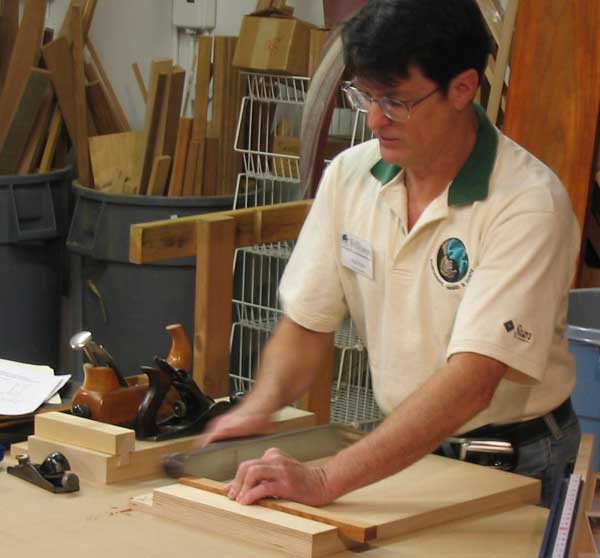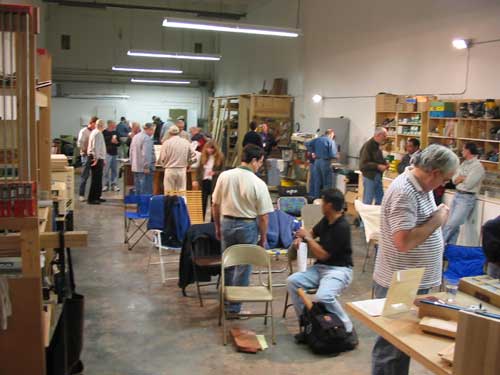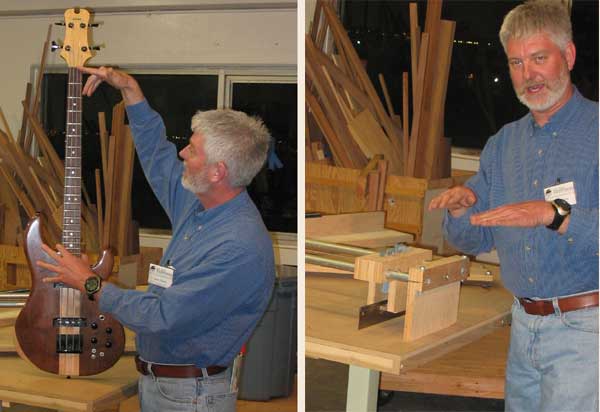
Last meeting
![]()
The November meeting was held in member Bruce Bell's spacious shop in San Francisco called the Double Dragon Woodworks. Craig began the meeting with announcements. Annual dues are due. The amount is $30 per year, $35 per couple. Mark Rand will be happy to take your money in cash or checks. You can mail a check to him at 665 27th St. S.F. 94131. We were contacted by a Fred Voltmer who has past issues of Fine Woodworking for sale. Contact him at fred@voltmer.com Because of some family problems the shop tour to John Schmidt's shop in Oakdale has been rescheduled for December 17. We are trying to form car pools. Contact Mark Rand if you want to go. Arnie Champagne is closing his woodworking school. He will, however, have one last dovetail class in January 2006 or any other class that people want. See his ad in the Classifieds. Harold Patterson announced a Toy Workshop to be held at Woodcraft on 11/20. Rafflemeister Stan Booker was still selling tickets for the very large Paduk board as well as a number of goodies for the door prizes including a sanding drum set donated by Bruce Bell.
Craig announced that the BAWA election of officers will be conducted at the December meeting. Come to the meeting and vote and vote often. The list of officer candidates is listed elsewhere in this newsletter. Committee Chairs are also listed but these are not voted on.
A call of guests to stand up and identify themselves was next. Oren Persing, recently graduated in Wood Technology from the University of Massachusetts, Amherst and is looking for employment in a shop here in the Bay Area. J.P. Frary is a high school teacher of Wood Shop in San Leandro. He is rebuilding the program and is looking for donated equipment and guest speakers furniture and cabinetry. Frank Ramsay who became a member does furniture. A big welcome was given to all.
Next was a Tech Talk by Neil White. He discussed and showed a shooting board. The shooting board can be used with a variety of tools in the wood shop: hand planes, saws and drills. An excellent example of a shooting board is described in the Lie-Nielsen handout -- David Charlesworth's Shooting Board and Fixtures (copy in the library). The basic board consists of a base made of ¾" MDF with a hardwood fence mounted at 90 degrees. With the work piece held against the fence, a plane can be used to shoot a square edge, a technique useful for squaring the end grain of glue joints. Several modifications to the basic board are possible:
- Add a shelf along the side of the board for the tool to ride upon. It acts as a guide for the tool and protects your bench top.
- Increase the height of the back fence to prevent splintering of the work piece along an unsupported edge.
- The side shelf can be angled down slightly thereby helping to hold the work piece in place.
- Hold the back fence in place with a sliding dovetail. This attachment permits easy adjustment and/or replacement of the fence.
A good shooting board will greatly improve the quality of your glue joints, making them square and true.

Bruce Bell then gave us some background on his operation and this new shop. Bruce builds outdoor furniture and structures such as arbors and gates. Until recently Bruce had operated his business from his garage shop in San Francisco. The old shop had 480 square feet of floor space and a ceiling height of 7 feet. He realized he would need to move when he struggled with building a 20' x 40' arbor in the garage shop. The new shop, located near SBC Park, in an industrial building, boasts 2150 square feet of floor space and a 25 foot ceiling. Some of his neighbors in the new building include a chocolate factory, two candy factories and a caterer. The smells, he claims, can be distracting.

Bruce has some substantial equipment in his new shop, including a 18" Rojek planer/jointer, a Rojek sliding table saw, a panel sander and more. He buys mostly 2 x 12 x 10' lumber and mills the wood himself. He works primarily with Western Red Cedar, Mahogany and Redwood. All of the equipment in the new shop had until just 2 or 3 weeks ago been in the garage shop and are on wheels. He has offered to let members use his heavy equipment for small jobs.
Bruce described how he got into this business. After a scuba diving accident left him with impaired hearing in one ear, he knew his diving career would be limited. One day while shopping for an outdoor planter with his wife, he was struck with the poor quality of products available. His wife, Terri encouraged him to make one instead; a project that required he buy some tools. His planter gained the attention of friends and he was asked to make more. More tools followed. Soon he was selling outdoor furniture and fixtures at the Marin Farmers Market. He joined two professional associations for landscape designers and architects and discovered he could work directly with the outdoor contractors. Contractors, he noted, are accustomed to fixed bid prices. The cost of the outdoor furniture and fixtures is usually only a small part of the total job cost. Bruce and his wife who is the mathematical brain of the team work together to develop this growing business, noted for its high quality and good design.
The main event of the evening was members' Jigs & Fixtures. There was some disagreement about whether this was the Fifth or the Twenty-fifth Annual Jigs and Fixtures event.
Jamie Buxton showed a fixture for making blind finger joints, a joint he had used in the chests he recently made. The concept is to cut aligning blind slots in the mitered edge of two pieces of a chest carcass that will be joined together to form a 90 degree angle. Small shop-made biscuits are glued in the slots of one piece. It is joined with the edge of the mating piece. The result is a 90 degree mitered joint with no visible reinforcement, either inside or outside the carcass. The face grain to face grain contact is maximized. To develop this unique joining method, Jamie cut even-width spaced slots in a plywood template with a dado blade on the table saw. The spacing between slots can vary. The reference point on the jig is off the front corner edge. This corner edge is aligned to the work piece. The slots are placed to overlap the mitered edge of the work piece. The depth of the slot is adjusted so that the slots will not cut through either edge of the miter. He uses a ¼" router bit and a collar on the router.
Jay Perrine who has been busily building cabinets discovered he could use his scrap plywood productively to build story sticks for locating biscuits holes and shelf holes.
John Blackmore, who recently completed his wood shop cabinets with a birch counter top, designed and built a chop saw fence system that attaches to the saw base using a tongue into groove assembly, thereby saving the countertop from drilled holes.
Richard Winslow showed a hole guide fixture for drilling holes for adjustable shelves. He uses a plunge router, guide collar and a ¼" up spiral bit. A guide pin indexes the fixture to the work piece.
Bruce Woods designed and built an electric guitar in Maple, Walnut and Rosewood. In guitar construction, the location and depth of the frets along the neck of the guitar is critical. The distance between the frets must be precise. Bruce devised a sliding miter box with a twin rail guide system for determining the precise location of the cut along the fret board. The guide moves 1/128" per turn along the twin rails of all-thread. The saw is held perpendicular to the fret board and shimmed with paper shims. The finish of the guitar was nitrocellulose.

The meeting ended with Mark Ferraro hauling away the large Paduk board on his motorcycle. Gene Wagg got a piece of Eucalyptus. Mark Rand got two sorely needed clamps, Harold Patterson a book about Wood. And the Bruce Bell donation was won by Bruce! A fitting end to another good meeting.
John Blackmore & Mark Rand